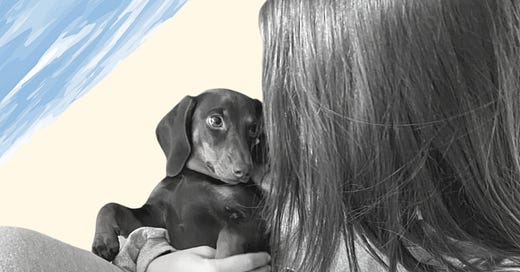Issue #34: What a clingy dachshund taught me about anxious attachment
Or, why I strive to be as needy as my parents' dog.
Alonement, the podcast, returns this Friday – tomorrow! – with Season 8, produced, hosted & edited by yours truly. New episodes will be released weekly on Fridays. Subscribe now on Apple, Spotify etc to be one of the first to hear it.
Last Saturday, I babysat. More accurately, I dog-sat – although, in lieu of grandchildren, I’d argue my parents’ dachshund, the baby/dog in question, is being treated much more akin to the former. Belle, who shares the same chocolate brown hair and saucer-shaped eyes as her Disney namesake, is clingy, even for a dog. The first week that Belle arrived at my parents’ house, my mother – convinced of the benefits of crate training – comforted her by sleeping on floor cushions besides the dog bed, human fingers meeting tiny paws through the bars in the early hours. She’s rarely left alone at home and, whenever there are people around, she’s seldom left to her own devices, preferring to be constantly entertained by her human playthings.
But that’s OK, because Belle’s a dog. Of course she spent the first six months of her existence doing ‘happy pees’ whenever a new person entered the room. Of course she howled at the front door last weekend when my parents left the house. Of course she rolls on to her back every time you walk into the room, in expectation of a belly rub. Of course she wants to be seen; heard; walked; stroked; fed; loved.
If Belle were a human, she’d be ‘anxiously attached’, a condition diagnosed on account of her attention-seeking behaviour, fear of abandonment and, OK, the spontaneous urination (although, to give her credit, she’s mostly stopped doing that now). My point is, her natural instincts – the behaviours we, as her human allies, sympathise with and soothe – would be pathologized. Her and her best mates would trade copies of bestselling non-fiction title Attached: Are You Anxious, Avoidant or Secure? She’d spend £75 a week on therapy. Every time someone broke up with her, she’d commit herself to a period of time ‘healing’ in the name of a secure, healthy relationship in the future. And then her hard-won Other Half would indirectly reap the benefits of her £75-a-week therapist, for free. Thankfully, she’s still a dog.
For the uninitiated, attachment theory was developed by British psychologist John Bowlby in the 1950s. Once most commonly applied to child development, it later became a popular discourse around romantic relationships with the publication of aforementioned book, Attached, in 2011. If you’re a married couple in your 60s, it’s likely you have no idea what attachment theory is (I quizzed my mum & dad, and my hypothesis was proved correct). If you’re single and below the age of, say, 40 – you’ll be served Instagram content about it on a daily, nay hourly, basis – a friend, newly single in his 30s, complained as much to me the other day – while it’s a regular ‘bingo card’ item in Millennial dating (‘What’s your attachment style?’, I was asked over dinner a couple of months ago).
And yet, I sort of wish I could unlearn my knowledge of attachment theory. Let me explain.
Keep reading with a 7-day free trial
Subscribe to The Shoulds by Francesca Specter to keep reading this post and get 7 days of free access to the full post archives.





